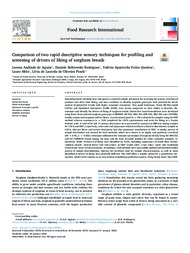Comparison of two rapid descriptive sensory techniques for profiling and screening of drivers of liking of sorghum breads.
Comparison of two rapid descriptive sensory techniques for profiling and screening of drivers of liking of sorghum breads.
Author(s): AGUIAR, L. A. de; RODRIGUES, D. B.; QUEIROZ, V. A. V.; MELO, L.; PINELI, L. de L. de O.
Summary: Rapid descriptive methods have emerged as a relatively simple alternative for screening the sensory attributes of products that drive their liking, and may contribute to identify sorghum genotypes with potential for development of gluten-free breads with higher consumer acceptance. Two rapid techniques, Check-All-That-Apply (CATA) and Optimized Descriptive Profile (ODP), were herein compared on their ability to describe, discriminate and identify the drivers of liking of sorghum breads. Gluten-free bread formulations were developed using flours from selected sorghum genotypes (CMSS005, BR 501, BRS 332, BRS 330, BRS 305 and 1167048), besides commercial sorghum and rice flours. A semi-trained panel (n = 18) evaluated the samples using the ODP method, whereas consumers (n = 124) completed the CATA questionnaire and rated the liking in a 9-point hedonic scale. A total of 24 and 11 sensory descriptors were perceived by assessors as different among samples for CATA and ODP, respectively, with color and appearance-related attributes critical to discriminate samples in CATA, whereas flavor and texture descriptors had also prominent contribution in ODP. A similar pattern of sample distribution was noticed for both methods, which were shown to be highly and positively correlated (RV = 0.92, p < 0.002). Genotypes influenced the consumer perception of sorghum breads, being the BRS 332 and the CMSS005 breads among the most and the least accepted samples for either consumer segment, respectively. While 10 drivers of liking were identified by CATA, including ?appearance of whole flour breads?, ?uniform alveoli?, ?neutral flavor? and ?soft aroma?, in ODP 'crumb color', 'crust color', 'spots' and traditional bread aroma? drove bread acceptance. In summary, both methods were successfully applied and provided similar pattern of sample discrimination, whereas the attributes used for sample characterization, as well as those identified as drivers of liking were generally different. The ODP offers a simpler option for a quantitative perspective, while CATA remains as an easy method considering qualitative aspects, being clearly faster than ODP.
Publication year: 2020
Types of publication: Journal article
Unit: Embrapa Maize & Sorghum
Keywords: Genótipo, Gluten-free bread, Glúten, Pão, Sorgo
Observation
Some of Embrapa's publications are published as ePub files. To read them, use or download one of the following free software options to your computer or mobile device. Android: Google Play Books; IOS: iBooks; Windows and Linux: Calibre.
Access other publications
Access the Agricultural Research Database (BDPA) to consult Embrapa's full library collection and records.
Visit Embrapa Bookstore to purchase books and other publications sold by Embrapa.

